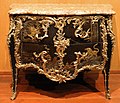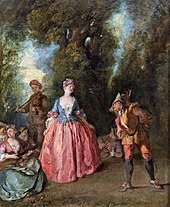Rococo


The Rococo is a style of European art from around 1720 to around 1780 and developed from the late Baroque (around 1700–1720). The starting point is France . The name comes from the French word rocaille (shell work) and describes a recurring ornament motif , which differs from baroque forms through asymmetry . The term Rococo was coined in 1797 by the painter Pierre Maurice Quays.
The Rococo was slowly replaced by Classicism from around 1770 . A transition style is called a braid style in German .
term
The term rocaille is derived from the two French words roc 'rock' and coquilles 'shells'. The derivation shows that it is primarily a decorative style. Therefore, even in the case of monumental architecture and the visual arts of that time, there is only limited reference to a separate style epoch. On the other hand, a strict distinction is made from the baroque , especially in the areas of interior design and applied arts . The term was formed in the second half of the 19th century.
The pathos of the Baroque was able to develop fully in the course of the Counter Reformation, the Catholic Reform and the associated doctrine and practice, as well as in the glorification of absolutist rulership. In contrast, in the subsequent Rococo period, a more playful ideal of beauty of elegant lightness and grace was worshiped. Characteristic of this construction and decoration style are excessive decorations on facades, in interiors, on furniture, everyday objects etc. and above all a preference for the irregular and for asymmetry , in contrast to the symmetry so central in the Baroque era. Solid forms are replaced by light, delicate, sinuous lines and often tendril-shaped borders.
In the iconography of secular art, the motifs show an increase in sensual, erotic aesthetics and a lascivious depiction of the gallant world. In architecture and the art of building, the great facade decoration takes a back seat in favor of a more extensive furnishing and accentuation of the interiors, just as the Rococo is primarily an art of interior decoration. In the courtly and increasingly also in the bourgeois environment, more or less luxuriously designed salons formed the centers of convivial entertainment. They thus developed into the dominant living spaces.
General tendencies
Exotic and porcelain
In the late baroque and rococo periods there was also a great preference for everything exotic, which is why chinoiserie in particular achieved its greatest popularity. The admiration for Chinese porcelain and East Asian lacquer work led to the establishment of porcelain cabinets or Chinese or Japanese lacquer rooms, for example in Schönbrunn , and even to small pavilions or pagodas in some palace parks (Chinese pavilion in Sanssouci , Potsdam).
Above all, porcelain production was rediscovered in Meissen , which also led to the establishment of other manufactories, such as in Nymphenburg , in Sèvres near Paris or in Capodimonte , Naples. In some palaces entire rooms were even decorated with products from European workshops instead of the valuable china porcelain. B. in the castle of Aranjuez or in the Salottino di Porcellana of Queen Maria Amalia of Saxony in the royal palace of Portici (1757–59; today in the Museo di Capodimonte , Naples).
The factories not only created all sorts of decorative objects - vases and figurines - because the love of porcelain was accompanied by an initial boom in the enjoyment of exotic drinks such as chocolate , tea and coffee , which have been increasingly popular in Europe since the 17th century Fashion had come. Corresponding services were produced, and the cheaper production of porcelain compared to Chinese originals ultimately promoted the refinement of customs, and entire dining services made of porcelain came into fashion.
"Petitessen"

Louis XIV. Of France had made his life a public event, in order to keep the nobility at court and to guide them by showing or withdrawing favor; the large apartments and even the park in Versailles should therefore impress with their magnificent beauty and serve as a representative demonstration of royal power. But from the 1670s onwards, the Sun King also had smaller and more intimate castles built with a more private character, which were not generally accessible and simpler in their furnishings and where the strict court etiquette was relaxed (the (destroyed) Trianon de porcelaine , the Trianon de marbre and the not preserved Marly ). This tendency to retreat into the private sphere intensified among other rulers in the 18th century. In the period of the Règence (1715–1723 / 30), morals had also loosened and the nobility lived far from strict court etiquette in their city palaces in Paris or enjoyed themselves at balls.
In the Rococo, the monumental splendor and powerful dynamism of the Baroque were replaced by a cultivated lifestyle and a light-footed, subtle attitude to life, paired with elegant, delicate sensuality and gallant manners. In (small) sculpture and especially in painting, private or even erotic themes often appear, not infrequently also in a lovely or even cute representation (e.g. paintings by Boucher , Meissen porcelain figures). This also aroused criticism, especially from the ranks of the Enlightenment , and there is talk of the age of decadence ; Voltaire calls it 'le siècle des petitesses ' (the century of the little things). The following adjectives were used to describe this period: “[…] smiling meaningfully, but seldom clearly laughing; amusing, piquant, capricious, funny, flirtatious, comedic ... “.
Visual arts
architecture

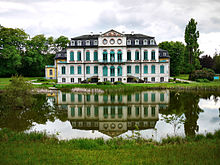
In architecture there are relatively few buildings whose style can be clearly assigned to the Rococo, since - as mentioned - it is more of a decorative style. The castles appear smaller, with the main building partially separated from service buildings, for example in Benrath Palace near Düsseldorf. In the interior design, the structuring elements of the classic-antique column order , pilasters , beams and friezes are now being dispensed with , instead the boundaries of the individual room parts (walls, ceiling, etc.) are blurred with the help of decorative ornaments. In addition to the official pompous representative rooms, there are now increasingly smaller and more intimate private rooms - such as the Petits Apartments Ludwig XV. and his daughters in Versailles - or even private houses and palaces, such as the Amalienburg in the park of Nymphenburg Palace . The attitude towards life calls for cheerful, light architecture with elegant and playful details.
In church construction, especially in the southern German-Austrian region, gigantic room creations are sometimes created for practical reasons alone, which, however, do not appear monumental, but are characterized by a unique fusion of architecture, painting, stucco, etc., often completely eliminating the boundaries between the art genres , and are characterized by a light-filled weightlessness, festive cheerfulness and movement (e.g. Wieskirche near Steingaden, etc.).
France
The Rococo originated in France, where it replaced the brief period of the Régence or "Regency", which as an art epoch spanned the period from 1715 to 1730, and in politics the years between 1715 and 1723, when Philip of Orléans took over the business of government in France during the minority of the future King Louis XV. directed.
Already in the Régence a lighter, more graceful style of decoration was developed. The heavy, straightforward classical-antique repertoire of forms of the Louis quatorze disappeared in favor of curves and arches. Wall paneling with often gilded boiseries on a white background is typical of French interior decoration . The decorative element of the rocaille appears for the first time around 1730 ( Salon Ovale in the Hôtel de Soubise , Paris).
The more delicate furniture showed itself with curved corpora , which were decorated with ornaments and with lavishly marketed surfaces. They wanted a higher degree of comfort and upholstered, for example. B. the seat and back of the armchair thicker or the chaise longue was created . Out of the need for useful and comfortable things, which should also satisfy the desire for playful luxury, new furnishings were made, such as tables with drawers and retractable compartments, dressing tables, game tables and cylinder desks or offices, their compartments and drawers behind an in Half- or quarter-circle roller shutters were found, among other things. The carpenters preferred oak, walnut, but also tropical woods such as satin wood or mahogany for their work. There were also refined everyday objects made of glass and porcelain.
Germany
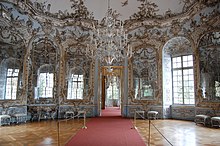
The Rococo style in Germany and Austria, under the already existing influence of the Italian Baroque, developed much more exuberant forms than in classicist France, and important Rococo decorations emerged in church buildings.
The Asam Church in Munich is on the threshold of the Rococo, but the typical main form of ornament , the rocaille , has not yet appeared here. They are first found in the late 1730s, but floral ornamental motifs still predominate at this time, such as in the Amalienburg in Munich-Nymphenburg, built by François de Cuvilliés . The rococo and rocaille are imported from France to Germany mainly through ornamental templates. The center of such engravings is Augsburg ; It was also called the “Augsburg taste”, and it is part of the repertoire of forms of many southern German plasterers until the Rococo decor in Dominikus Zimmermann's work reaches its climax: “built rocailles” appear in the choir of the Wieskirche . His work in the construction and stuccoing of the pilgrimage church Steinhausen (1727–1733) between Bad Schussenried and Biberach should also be emphasized . Other significant Rococo creations are the Cuvilliés Theater in Munich and Wilhelmsthal Palace near Kassel.
Regional special forms
In the German-speaking area, various forms of Rococo in different regions are sometimes given special names, not least because they were originally independent countries in the 18th century, whose buildings were shaped by the taste and means of a certain prince or princess.
Significant elements of the South German Rococo can be found in the Würzburg Residence . In Balthasar Neumann's main work , the stucco work was done by Antonio Bossi . Particularly noteworthy here are the “White Hall” and the “Imperial Hall” with its elaboration. Among other things, Balthasar Neumann had the unique audience room furnished by the highly talented cabinet maker Ferdinand Hundt and praised him for “understanding the decorative tailoring best of all”. Ferdinand Hundt, Antonio Bossi and Johann Wolfgang van der Auwera created the new taste of the Würzburg Rococo in the residence .
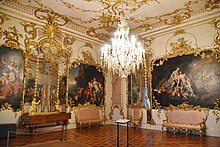
Probably the best-known special form of German Rococo is the Frederician Rococo in Prussia, named after Frederick the Great , which is not quite as playful and exuberant compared to the Bavarian variant, but tends to be ostentatious. Exemplary is the elegant interior decoration of Sanssouci Palace (e.g. concert room), as well as some interiors in the New Palace of Potsdam, where mixed forms with classicism occur (other rooms, such as the galleries, are completely classicistic).
The Bayreuth Rococo , which was created under Margravine Wilhelmine in Bayreuth between 1740 and 1760 , is also regarded as an independent development . Typical elements are delicate stucco ornaments, most of which are by Giovanni Battista Pedrozzi . This style was most pronounced in the new palace of the Hermitage, the interior of which was unfortunately destroyed in the war. The apartments in the New Bayreuth Palace , in the Old Hermitage Palace and the Bayreuth Palace Church have been preserved .
Austria
In today's Austria one can find important examples of the Rococo - a strict demarcation from southern Germany is not possible or sensible and does not correspond to the historical situation in the 18th century. Instead, one speaks in principle of the South German-Austrian Rococo. On the other hand, with the Theresian style named after Maria Theresia , which tends a little more towards the lovely, there is also its own conceptual formation. The best-known example of this is the interior decoration of Schönbrunn Palace in Vienna (although most of the red and white furniture dates from the 19th century and belongs to the Neo- Rococo). Other important examples are Leopoldskron Castle in Salzburg , Engelszell Abbey and Wilhering Abbey in Upper Austria . The Wilhering Collegiate Church is the most important Rococo sacred building in Austria and one of the most important Rococo buildings in the German-speaking world .
Italy
A comprehensive study of the Rococo in Italy does not seem to be available so far. In some cases, it is not easy to distinguish it from the Italian late baroque, because, in contrast to the classical canon of forms in France under Louis XIV, in Italy one was already much freer and more intoxicating in the decorations of the palaces and churches. After 1700 decorations emerged which, despite their exuberance, already use great delicacy and elegance and in some cases similar ornamentation as in the Rococo, e.g. B. Shells, which, however, often remain more symmetrical in the large design than in the later Rococo. Nevertheless, there are some very clear and imaginative examples of rococo-style room creation in Italy, including in the Palazzina Stupinigi and the Palazzo Reale in Turin (including the Galleria del Daniel and the Chinese Cabinet), or in Venetian palaces such as the Ca 'Rezzonico , the Casino of the procurator Venier, in the Palazzo Baglioni, in the Palazzo Pisani Moretta and in the Palazzo Foscarini ai Carmini, which often have colorful stucco decorations as well as spectacular ceiling paintings by Tiepolo , Giambattista Crosato and other painters. A well-known example of Rococo is the large gallery in the Palazzo Pianetti in Jesi . In Rome, the tradition of classical antiquity and the Renaissance was very strong, and the palaces there therefore have a lot of Rococo furniture, but entire room creations are rare: the Palazzi Rondinini and Chigi-Odescalchi , as well as the mirror gallery of the Palazzo , which was built in 1734, are worth mentioning Doria-Pamphilj . In Sicily , noteworthy Rococo decorations can be found in the Palazzi Valguarnera-Gangi , Butera and Comitini (all in Palermo ), in the Villa Ajroldi (Palermo), and in the Palazzo Biscari in Catania .
Other countries
The style is also taken up in Russia , but here with a tendency to pomp and pomp and also to the monumental ( Katharinenschloss in Tsarskoje Selo, Jonas staircase in the Winter Palace ). The most important architect of the Russian Rococo was the Italian Bartolomeo F. Rastrelli .
A famous rococo castle in Portugal is the Palácio de Queluz near Sintra , the interiors of which are partly classical. The park has retained its original shape and also has valuable rococo-style azulejo decorations.
- Castle construction
Stone hall in Nymphenburg Palace
Great staircase in Peterhof Palace , near Saint Petersburg
Ceiling with chinoiseries in the porcelain cabinet (Salottino di Porcellana) of Maria Amalia of Saxony (1757–59), Museo di Capodimonte , Naples
Cabinet in the New Palace , Potsdam (late transition phase to the plait style )
Chinese tea house in Sanssouci Park
- Sacred buildings
Basilica of St. Alexander and Theodor in Ottobeuren
Ceiling fresco of the Wilhering collegiate church
Important Rococo buildings in the German-speaking area
Secular buildings
|
Sacred buildings
|
Important builders of the Rococo
Garden art
Garden art from around 1730 and 1760 was only assigned to the Rococo at the beginning of the 20th century. She mostly makes use of the elements of the French baroque garden , modifies them and uses them differently. More and more natural elements such as lawns, flowering bushes and fruit trees are included. Elements of chinoiserie and classicism can also be associated with the rococo garden. In some cases, one can speak of mixed forms between baroque and landscape gardens. In France, Ingrid Dennerlein still defined the garden art of the Régence between baroque and rococo . While for France, Germany and Scandinavia it can be considered clear what is meant by rococo gardens, the use of the term for the gardens of this time in England, Italy and Spain sometimes causes difficulties.
Important rococo gardens that are still recognizable as such today
sculpture
Even in the Rococo, French sculpture tended towards classical features ( René Fremins , Jean-Baptiste Lemoynes II , Edmé Bouchardon ). In Italy, the moving Baroque ideal of figures , which goes back to Bernini , remains predominant (but Giovanni Maria Morlaiter is different ). Southern Germany has an Italian influence and is a center of rococoplasty. A number of outstanding sculptors are involved in the design of palaces, castles and churches. Wood, the preferred material, is enhanced by colored or white and gold frames. In addition, stucco is also used for the architecture-oriented sculpture. In the Würzburg Residence , the cabinetmaker Ferdinand Hundt , the plasterer Antonio Giuseppe Bossi and the draftsman and sculptor Johann Wolfgang van der Auwera shape the taste of the “Würzburg Rococo”. In Bavaria, alongside François de Cuvilliés the Elder , Johann Baptist Straub and his pupil Ignaz Günther are among the most important masters. In Berlin, the brothers Johann Michael Hoppenhaupt , Johann Christian Hoppenhaupt and Johann August Nahl brought out the bloom of the Frederician Rococo. In Vienna, Georg Raphael Donner represents his own classical style.
The porcelain sculpture (with the centers Meißen , Nymphenburg and Sèvres ) prefers idyllic and bucolic themes.
Important Rococo sculptors
|
|
painting

The representation of the new attitude towards life in France moves away from the previous state idea of painting under Louis XIV and ends in a cheerful play of colors and curved lines. Painting discovered the delicate tones of pastel painting (e.g. Rosalba Carriera , Maurice Quentin de La Tour ), and in oil painting , too, there is a clear brightening of the color scale, towards light pastel colors with the breaking of all tones into silvery ( depending on the artist). White shows itself as materialized light with decorative, cheerful, festive effects. The playful element can be found in small-format pictures, in porcelain painting and especially in the chinoiseries.
In the iconography of a tendency towards secularization, a sensual aesthetics and an erotic and lascivious display of gallant world can be observed. In the picture programs, Helios - Apollo or Hercules lose their priority over Venus and Pan and the "lower gods". The desire to live in Arcadia is expressed in love scenes , atmospheric idylls, bucolic landscapes and outdoor festivities. The tradition of pastoral painting is revived. The focus is on the decorative and the composition of the picture, an idyllic background landscape, details such as fabrics, vases etc., and less psychological elements. In French painting, the representation of a “gallant” life can be found in the new image type of the fête galante , created by Antoine Watteau in the Régence , which was continued in the beginning Louis-quinze by Jean-Baptiste Pater and Nicolas Lancret . As a poetic ideal embodiment of French elegance, this type of painting met with particular interest from German princes, especially at the courts in Dresden , Berlin and Potsdam , where the foundations for the collections that still exist today were laid in the corresponding art museums and palaces.
The great masters of French Rococo with the depiction of shepherd games and erotically tinged mythological scenes include Jean-Honoré Fragonard and François Boucher , who was a master of decoration and 40 years of French Rococo in the era of Louis XV. coined.
At this time, Italian painting could already look back on a long tradition of ceiling frescoes, mythological scenes and religious painting, which in the late Baroque and Rococo style was based on the soft, lovely style of Correggio or on the fresco art and the erotic scenes of Luca Giordano or Sebastiano Ricci could look back, or on the flickering style of Pellegrini, all of which - albeit in some cases much earlier - can be regarded as important forerunners and inspiration of rococo painting, far beyond Italy. Important Italian painters of the era were Jacopo Amigoni , who also created many erotic scenes in the taste of the time, as well as Corrado Giaquinto , Gianantonio Guardi , and the Neapolitans Francesco De Mura and Sebastiano Conca . The Venetian Giambattista Piazzetta mostly cultivated a Tenebroso style even in the Rococo , in contrast to his somewhat younger colleague Giovanni Battista Tiepolo , who is considered the “last grand master of Venetian painting ” and, in addition to numerous works for Venetian churches and palaces, one in Germany created his masterful ceiling frescoes in a light-filled color in the stairwell of the Würzburg residence. The famous vedutas and capricci by Canaletto , Bernardo Bellotto and Francesco Guardi were also made in Venice , which were also popular with aristocratic tourists from the rest of Europe, and thus ended up on the walls of English or German castles. In addition, carnival representations, portraits and genre scenes were popular subjects, with masters such as Pietro Longhi or Giovanni Domenico Tiepolo , or the aforementioned pastel painter Rosalba Carriera , who is famous throughout Europe . Francesco Zuccarelli painted mythological or pastoral landscapes .
In England, William Hogarth , Joshua Reynolds , and Thomas Gainsborough are among the outstanding Rococo painters.
In the sacred area, painters tend towards feeling, devotion and legends of saints. In complete contrast to this, however, is the glorification in the ceiling painting, which also uses the stylistic device of illusion painting. A previously unknown integration of fresco painting and architecture and ornaments is emerging, especially in residences and churches in southern Germany and Austria. This is where the great masterpieces of European fresco painting are created, with representatives Giovanni Battista Tiepolo , Johann Georg Bergmüller , Johann Baptist Zimmermann , Mathäus Günther , Daniel Gran , Franz Anton Maulbertsch , Paul Troger .
- Paintings (examples)
Jean François de Troy : The Declaration of Love , 1731, Charlottenburg Palace , Berlin
Jean Siméon Chardin : Maid Washing Up , ca.1738, National Gallery of Art , Washington
Jacopo Amigoni : Bacchus and Ariadne , around 1740, Art Gallery of New South Wales , Sydney
Giovanni Battista Tiepolo : Rinaldo and Armida in the Garden , 1742–45, Art Institute of Chicago
Maurice Quentin de La Tour : Abbé Jean-Jacques Huber, reading , pastel on paper, 1742, Musée Antoine Lécuyer, Saint-Quentin
Corrado Giaquinto : Rest on the Flight into Egypt , approx. 1740–1742, Louvre, Paris
Important Rococo painters
applied Arts

Furniture and interior
While in the Baroque style the furniture was predominantly angular and strict, despite its manifold structure and dominant ornamentation, the Rococo did away with the static framework and the linear rigor and transformed almost every element into curved and curved forms, which was extremely "playful", renounced symmetry and appeared as an era of embellished, swelling and supple elegance. Here, too, the central motif of the Rococo is the rocaille. The seating furniture, chests of drawers and tables had curly legs. The furniture feet often show carvings or metal applications in the form of plants, animal feet or shell motifs. The console table is a further development and only needs two feet because it is attached to the wall. The so-called Bergère , a forerunner of the armchair with upholstered armrests and a loose seat cushion, was used for comfort . A new development is the chaise longue (French: long chair), which connects an armchair with its footstool to form a long piece of furniture. In the furniture art went from France a particularly dominant influence, the rococo corresponds to the style XV Louis .
- Furniture art
Chest of drawers with Japanese lacquer decor by Jean de Forges, ca.1750 , Museu Calouste Gulbenkian , Lisbon
Rococo console with barometer (completed 1774) by Jean-Joseph Lemaire in the Grand Cabinet of the Dauphine, Palace of Versailles
Mechanical table with marquetry made of various woods by Jean-François Oeben , approx. 1761–1763, Metropolitan Museum , New York
performing Arts
music
The term “Rococo” is not commonly used in music, although there are parallel appearances. See therefore:
literature
In literature, Rococo refers to an epoch of the early Enlightenment that is still strongly influenced by shepherd poetry and the Baroque and accordingly incorporates playful and also erotic elements, but on the other hand is close to sensitivity due to its subjective emotional flow and expresses an individually and rationally founded world of experience with all the sensual pleasure. While the tragedy and grandeur of the Baroque flatten out, reason, practicality, wellbeing, golden mean and joy in graceful style take the place of the puzzles and wonders of the afterlife.
Eminent authors
See also
literature
- Christoph Kurzeder , Ariane Mensger and others: With body and soul. Munich Rococo from Asam to Günther. Edited by the art gallery of the Hypo-Kulturstiftung. Sieveking Verlag, 2014, ISBN 978-3-944874-15-9 .
- Alfred Anger: Literary Rococo. Metzler, Stuttgart 1990, ISBN 3-476-10025-1 .
- Hermann Bauer , Hans Sedlmayr : Rococo: Structure and essence of a European era. DuMont, Cologne 1992.
- William Barcham: The Venetian Rococo - Tiepolo and the 18th Century. In: Venice - Art and Architecture. Vol. 2, ed. v. Giandomenico Romanelli. Könemann, Cologne (originally Magnus Edizioni / Udine), 1997, pp. 640–691.
- Adriano Mariuz, Giuseppe Paranello: The interior decorations of the Venetian palaces - from the baroque splendor to the elegance of the rococo. In: Venice - Art and Architecture. Vol. 2, ed. v. Giandomenico Romanelli. Könemann, Cologne (originally Magnus Edizioni / Udine), 1997, pp. 582–639.
- Matthias Luserke-Jaqui among others: Literature and culture of the Rococo. Vandenhoeck & Ruprecht, Stuttgart 2001, ISBN 3-525-20700-X .
- Hans Rose : late baroque. Studies on the history of secular building in the years 1660–1760. Munich 1922.
- Martin Schieder: Rococo. In: Theological Real Encyclopedia . Vol. XXIX, Berlin / New York 1998, pp. 345-349.
- Claus Bernet : Baroque and Rococo. Norderstedt 2015, ISBN 978-3-7357-8841-2 .
- Friedrich Sengle : Enlightenment and Rococo in German literature. Winter, Heidelberg 2005, ISBN 3-8253-5010-X .
- Karsten Harries : The Bavarian Rococo Church. The irrational and the sacred. Hawel, Dorfen 2009.
Web links
Individual evidence
- ↑ a b c Johannes Jahn , Stefanie Lieb : Dictionary of Art (= Kröner's pocket edition . Volume 165). 13th, completely revised and expanded edition. Kröner, Stuttgart 2008, ISBN 978-3-520-16513-8 , p. 713 f.
- ↑ Pierre-Maurice Quays. Retrieved March 2, 2021 .
-
↑ Joseph von Eichendorff: The nobility and the revolution.
Wilhelm Heinrich Riehl: The struggle of the Rococo with the braid (1853), in whose: Culturstudien aus three centuries, 1859. - ↑ Egon Friedell: Cultural History of the Modern Age. CH Beck'sche Verlagsbuchhandlung, Munich 1931, p. 563 ff.
- ↑ Noël Riley (Ed.): Crafts & Design. Styles, techniques, decorations from the Renaissance to the present. 2004, p. 114.
- ↑ i.e. the assembled sides of a piece of furniture or component (floor, side parts, lid, back wall and front)
- ^ After Erich Bachmann: New Bayreuth Palace . Official leader. 4th edition, Munich 1980.
- ↑ Also including chinoiseries; see Andreina Griseri: The Stupinigi Hunting Lodge near Turin. Atlantis, Manfred Pawlak, Herrsching 1989.
- ↑ Adriano Mariuz, Giuseppe Paranello: The interior decorations of the Venetian palaces - from the baroque splendor to the elegance of the rococo. In: Venice - Art and Architecture, Vol. 2. ed. v. Giandomenico Romanelli, Könemann / Cologne (originally Magnus Edizioni / Udine), 1997, pp. 582-639.
- ↑ Many palaces in Venice are privately owned and not open to the public, information and some illustrations contain: Adriano Mariuz, Giuseppe Paranello: The interior decorations of the Venetian palaces - From the baroque splendor to the elegance of the Rococo. In: Venice - Art and Architecture, Vol. 2. ... Könemann / Cologne, 1997, pp. 582–639, in detail p. 600 (Palazzo Foscarini ai Carmini), p. 614 f (Palazzo Pisani Moretta), p . 627 (Casino of the Prokuratorin Venier), p. 632 (Cà Rezzonico), p. 639 (Pal. Baglioni)
- ↑ Only Palazzo Doria-Pamphilj is open to the public, the other two are privately owned. Caroline Vincenti & Roberto Schezen: Roman Palaces. Bechtermünz (& Weltbild) Verlag, Augsburg, 1998, p. 186f (Pal. Chigi-Odescalchi), p. 210-12 (Pal. Doria-Pamphilj), p. 221, 224, 228f (Pal. Rondinini).
- ↑ Angheli Zalapí & Gioacchino Lanza Tomasi: Paläste auf Sizilien, Könemann, Cologne 2000, pp. 126–137 (Pal. Butera), 164–179 (Pal. Valguarnera-Gangi), 180–191 (Pal. Biscari), 192– 201 (Pal. Comitini), 232–243 (Villa Ajroldi)
- ^ Paul Höckendorf: Sanssouci at the time of Frederick the Great and today . Berlin 1903.
- ↑ Ingrid Dennerlein: The garden art of the Régence and the Rococo in France . Worms 1981.
- ↑ a b c d Dörfler: Lexicon of Art, Painting, Architecture, Sculpture. Volume 9, Nebel, Eggolsheim 2006, ISBN 3-89555-386-7 , p. 115 ff.
- ^ Herder Freiburg, with contributions from Hubert Damisch: The French painting. Basel, Vienna, Freiburg 1983, ISBN 3-451-18937-2 , p. 120.
- ^ Hubert Krins: Baroque in Southern Germany . Konrad Theiss Verlag, Stuttgart 2001, ISBN 3-8062-1420-4 , p. 24 f.
- ↑ William Barcham: The Venetian Rococo - Tiepolo and the 18th century. In: Venice - Art and Architecture, Vol. 2. ed. v. Giandomenico Romanelli, Könemann / Cologne (originally Magnus Edizioni / Udine), 1997, pp. 640–691; to Ricci and Pellegrini, pp. 640 and pp. 651-653, 659, 662-665.
- ↑ William Barcham: The Venetian Rococo - Tiepolo and the 18th century. In: Venice - Art and Architecture, Vol. 2. ..., Könemann / Cologne (originally Magnus Edizioni / Udine), 1997, pp. 640–691; here on Piazzetta, pp. 656 and 667–673.
- ^ Hermann Glaser , Jakob Lehmann, Arno Lubos : Ways of German literature. Ulstein, 1997, p. 138.

















